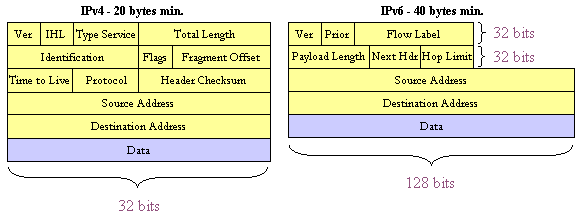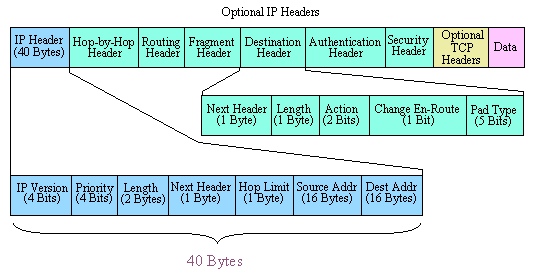|
Introduction
IP version
6 (IPv6) is a new version of the Internet Protocol based on IPv4.
Its designed to be an evolutionary step from the current IPv4
and will interoperate with IPv4 equipment allowing for a gradual
and piecemeal introduction into the network. Major Changes from
IPv4 are:
-
Addresses enlarged from 32 to 128 bits
-
Allow mobility of computers
-
Guaranteed Quality of Service for connections
-
Direct support for security protocols (encryption,
network)
-
Evolutionary migration
to enable functions
There are a number
of reasons that IPv6 is needed: there is a shrinking pool of available
IP addresses, the accumulation of changes to IPv4 has made it
very cumbersome, new applications and devices do not fit into
the original assumptions about the IP network, and there is a
great deal more need for security of data transmissions.
IPv6 supports large hierarchical addresses that will allow the
Internet to continue to grow and provide new routing capabilities
not built into IPv4. It has a new concept of an Anycast addresses
which can be used so that the message finds its way through the
network along a particular route such as ensuring that the packet
stays within a single ISPs network. It also has a "local
use address" mechanisms allowing for communications within
a small area and not taking valuable public addresses.
The changes
from IPv4 to IPv6 fall primarily into the following categories:
-
Expanded Routing and Addressing Capabilities
IPv6 increases the IP address size from 32 bits to 128 bits,
to support more levels of addressing hierarchy and a much
greater number of addressable nodes, and simpler auto-configuration
of addresses.
-
A new type of address called an "Anycast
address" is defined to identify sets of nodes where a
packet sent to an Anycast address is delivered to one of the
nodes. The use of Anycast addresses in the IPv6 source route
allows nodes to control the path that their traffic flows.
-
Header Format Simplification
Some IPv4 header fields have been dropped or made optional,
to reduce the common-case processing cost of packet handling
and to keep the bandwidth cost of the IPv6 header as low as
possible despite the increased size of the addresses. Even
though the IPv6 addresses are four time longer than the IPv4
addresses, the IPv6 header is only twice the size of the IPv4
header.
-
Quality-of-Service Capabilities
A new capability is added to enable the labeling of packets
belonging to particular traffic "flows" for which
the sender requests special handling, such as non-default
quality of service or "real- time" service.
-
Authentication and
Privacy Capabilities
IPv6 includes the definition of extensions that provide support
for authentication, data integrity, and confidentiality. This
is included as a basic element of IPv6 and will be included
in all implementations.
The Technical Aspects of IPv6
A comparison of the fields in the IPv4
packet header vs. the IPv6 fields is shown in Figure 1.

Figure 1. Comparison of IPv4 packet header with
IPv6
In both IPv4 and IPv6, there may be optional
headers appearing after the main header and before the data. Most
IPv6 extension headers are not examined or processed by any router
along a packet's delivery path until it arrives at its final destination.
IPv6 extension headers can be of arbitrary length. The format
of the IPv6 packet is shown below in Figure 2 .

Figure 2. IPv6 Packet Format
Where:
Ver
4-bit Internet Protocol version number = 6.
Prio
4-bit Priority value.
Flow
Label 24-bit field. See IPv6 Quality of Service section.
Payload
Length 16-bit unsigned integer. Length of payload, i.e., the
rest of the packet following the IPv6 header, in octets.
Next
Hdr 8-bit selector. Identifies the type of header immediately
following the IPv6 header. Uses the same values as the IPv4 Protocol
field.
Hop
Limit 8-bit unsigned integer. Decremented by 1 by each
node that forwards the packet. The packet is discarded if Hop
Limit is decremented to zero.
Source
Address 128 bits. The address of the initial sender of the packet.
Destination
Address 128 bits. The address of the intended recipient of the
packet (possibly not the ultimate recipient, if an optional Routing
Header is present).
The IPv6 extension headers that are currently
defined are:
Routing
Extended Routing (like IPv4 loose source route).
Fragmentation
Fragmentation and Reassembly.
Authentication
Integrity and Authentication. Security
Encapsulation
Confidentiality.
Hop-by-Hop
Option Special options which require hop by hop processing.
Destination
Options Optional information to be examined by the destination
node.
IPv6 Addressing
Unlike IPv4 addresses that refer to a
node, IPv6 addresses are 128-bits long and are identifiers for
individual interfaces. A node may be referenced by any of that
node's interface. A single interface may be assigned multiple
IPv6 addresses of any type.
There are three types of IPv6 addresses. These are unicast, anycast,
and multicast. Unicast addresses identify a single interface.
Anycast addresses identify a set of interfaces such that a packet
sent to a anycast address will be delivered to one member of the
set. Multicast addresses identify a group of interfaces is delivered
to all of the interfaces in that group. There are no broadcast
addresses in IPv6, their function being superseded by multicast
addresses.
IPv6 Routing
Routing in IPv6 is almost identical to
IPv4 routing under CIDR except that the addresses are 128- bit
IPv6 addresses instead of 32-bit IPv4 addresses. With very straightforward
extensions, all of IPv4's routing algorithms (OSPF, RIP, IDRP,
ISIS, etc.) can used to route IPv6.
IPv6 also
includes simple routing extensions that support powerful new routing
functionality. These capabilities include:
-
Provider Selection (based on policy, performance,
cost, etc.)
-
Host Mobility (route to current location)
-
Auto-Readdressing (route to new address
IPv6 Quality-of-Service Capabilities
The Flow Label and the Priority fields
in the IPv6 header may be used by a host to identify those packets
for which it requests special handling by IPv6 routers, such as
non-default quality of service or "real-time" service.
This capability is important in order to support applications
which require some degree of consistent throughput, delay, and/or
jitter. This type of application are commonly described as "multi-
media" or "real-time" application.
Flow Labels
The 24-bit Flow Label field in the IPv6
header may be used by a source to identify those packets requiring
special handling by the IPv6 routers. This is used to provide
Quality of Service for real-time applications.
There may be multiple active flows from a source to a destination,
as well as traffic that is not associated with any flow. A flow
is uniquely identified by the combination of a source address
and a non- zero flow label. Packets that do not belong to a flow
carry a flow label of zero.
Priority
The 4-bit Priority field in the IPv6
header enables a source to identify the desired delivery priority
of its packets, relative to other packets from the same source.
The Priority values are divided into two ranges: Values 0 through
7 are used to specify the priority of traffic for which the source
is providing congestion control, i.e., traffic that "backs
off" in response to congestion, such as TCP traffic. Values
8 through 15 are used to specify the priority of traffic that
does not back off in response to congestion, e.g., "real-time"
packets being sent at a constant rate.
For congestion-controlled traffic, the
following Priority values are recommended for particular application
categories:
0 Uncharacterized
traffic
1 "Filler" traffic (e.g., netnews)
2 Unattended data transfer (e.g., email)
3 (Reserved)
4 Attended bulk transfer (e.g., FTP, HTTP, NFS)
5 (Reserved)
6 Interactive traffic (e.g., telnet, X)
7 Internet control traffic (e.g., routing protocols, SNMP)
For non-congestion-controlled traffic, the lowest Priority value
(8) should be used for those packets that the sender is most willing
to have discarded under conditions of congestion (e.g., high-fidelity
video traffic). The highest value (15) should be used for those
packets that the sender is least willing to have discarded (e.g.,
low-fidelity audio traffic).
Transition to IPv6
There is a significant amount of equipment
installed around the world that operate using IPv4. The reality
of IPv6 is that it must continue to operate with IPv4 equipment
without disruption. Since its not feasible to upgrade the entire
world network, IPv6 devices does allow the IPv4 devices to be
present anywhere in the network and still provide its advanced
capabilities.
The IPv6
allows the transition from IPv4 through mechanisms allowing for
a smooth transition. Some of the assumptions of the IPv6 are:
-
Incremental upgrade and deployment. Individual
IPv4 hosts and routers may be upgraded to IPv6 one at a time
without requiring any other hosts or routers to be upgraded
at the same time. New IPv6 hosts and routers can be installed
one by one.
-
Minimal upgrade dependencies. The only prerequisite
to upgrading hosts to IPv6 is that the DNS server must first
be upgraded to handle IPv6 address records. There are no prerequisites
to upgrading routers.
-
Easy Addressing. When existing installed IPv4
hosts or routers are upgraded to IPv6, they may continue to
use their existing address. They do not need to be assigned
new addresses.
-
Low start-up costs. Little or no preparation
work is needed in order to upgrade existing IPv4 systems to
IPv6, or to deploy new IPv6 systems.
The mechanism
for transitioning is:
-
An IPv6 addressing structure that embeds IPv4
addresses within IPv6 addresses, and encodes other information
used by the transition mechanisms.
-
A model of deployment where all hosts and routers
upgraded to IPv6 in the early transition phase are "dual"
capable (i.e. implement complete IPv4 and IPv6 protocol stacks).
-
The technique of encapsulating IPv6 packets within
IPv4 headers to carry them over segments of the end-to-end
path where the routers have not yet been upgraded to IPv6.
-
The header translation technique to allow the
eventual introduction of routing topologies that route only
IPv6 traffic, and the deployment of hosts that support only
IPv6.
It is likely that the first deployments
will be in large corporate networks since the benefits of IPv6
are most suitable and cost effective for this group. This will
be followed by large backbone systems, and then migrating to edge
routers that access the networks. Small business and home users
may the last to participate in the migration to IPv6.
More Information
In Summary:
-
IPv6 provides solutions for the increasing the
available address, allows mobile nodes, provides better Quality
of Service, and increases security.
-
IPv6 is compatible with todays IPv4 networks
and there should be a smooth migration o IPv6.
-
Corporate networks and central node routers will
be upgraded first followed by other network elements.
|

